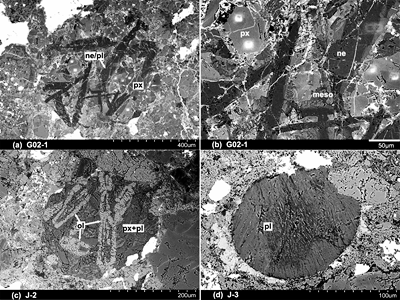New work about formation of aluminum-rich chondrules from ordinary chondrites accomplished by Purple Mountain Observatory
2015-11-16Recently, Science China: Earth Sciences published the new work of Prof. Hsu’s team, named in situ SIMS oxygen isotope analyses: evidence for the formation of aluminum-rich chondrules from ordinary chondrites, which provided important constraints on the formation of aluminum-rich chondrules.
Aluminum-rich chondrules (ARCs) are a rare constituent in primitive chondrites. They have bulk Al2O3 contents higher than 10%. With regard to mineralogy, bulk chemical compositions and oxygen isotopes, ARCs are intermediate between Ca, Al-rich inclusions (CAIs) and ferromagnesian chondrules. Thus, ARCs play an important role in revealing their temporal and petrogenetic relationships.
Oxygen is the principal constituent of most phases, and its isotopic composition and variation can effectively trace the reservoir and the nebular history of CAIs and chondrules. Using the Cameca IMS 7f-GEO ion microprobe at California Institute of Technology, Jiang et al. (2015) analyzed oxygen isotope compositions of aluminum-rich chondrules in nineteen Antarctic samples collected by Chinese Antarctic Research Expedition and six other UOCs (Semarkona, Krymka, Sharps, Chainpur, Julesburg and Dimmitt) (Figure 1).
In situ analyses results show that ARCs have oxygen isotopic compositions (δ18O ~ –6.1‰ to 7.1‰; δ17O ~ –4.5‰ to 5.1‰) close to ferromagnesian chondrules but far more depleted in 16O than CAIs (δ18O ~ ?40‰; δ17O ~ ?40‰). Most ARCs plot close to the terrestrial mass fractionation (TF) line, and a few between the TF and carbonaceous chondrite anhydrous mixing (CCAM) lines. Plagioclase, nepheline and glass suffered O-isotopic exchanges during the metamorphism processes in the parent body. Spinel, olivine and pyroxene represent the primary O-isotopic compositions of ARCs, and define a fitted line with a slope of ~ 0.7 ± 0.1 (Figure 2). It concluded that unlike carbonaceous chondrites, aluminum-rich chondrules in ordinary chondrites are not a simple mixing product of chondrules and inclusions, but probably experienced extensive oxygen isotope exchange with a 16O-poor nebular gas reservoir during multiple melting episodes.

By with JIANG Yun
Figure 1 Back-scattered electron (BSE) images of plagioclase-type aluminum-rich chondrules in ordinary chondrites collected by Chinese Antarctic Research Expedition in Antarctica.

By with JIANG Yun
Figure 2 Comparison of ARCs from ordinary chondrites on the three oxygen isotopic compositions plot. Error bars are 2σ. The gray ellipse covers the range of in situ O-isotopic compositions of ferromagnesian chondrules in UOCs. In addition to TF and CCAM lines, also plotted is the Y&R line defined by unaltered minerals from a Type B Allende CAI.

 Search
Search

